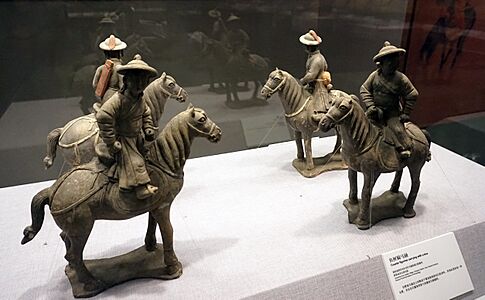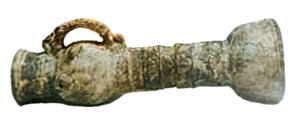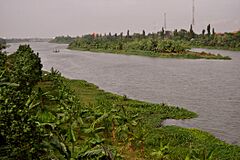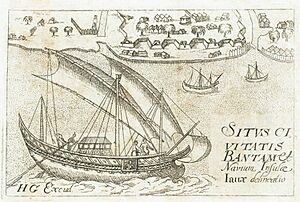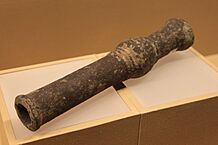Mongol invasion of Java facts for kids
Quick facts for kids Mongol invasion of Java |
||||||||||
|---|---|---|---|---|---|---|---|---|---|---|
| Part of the Mongol invasions and conquests and Kublai Khan's campaigns | ||||||||||
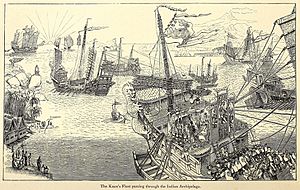 Kublai Khan's fleet passing through the Indonesian archipelago, by Sir Henry Yule (1871) |
||||||||||
|
||||||||||
| Belligerents | ||||||||||
| Yuan dynasty | Kediri Kingdom | |||||||||
| Commanders and leaders | ||||||||||
|
|
|
||||||||
| Strength | ||||||||||
|
Yuan dynasty: 20,000–30,000 soldiers500–1,000 ships |
Javanese forces: More than 100,000 soldiers (Mongol claim)20,000–30,000 soldiers (modern estimate) Unknown number of ships |
|||||||||
| Casualties and losses | ||||||||||
|
Shi Bi's troops: More than 3,000 soldiers killed |
Kediri's troops: More than 5,000 killed and drowned | Majapahit troops: Unknown | ||||||||
In 1293, the Yuan dynasty, led by Kublai Khan, tried to invade Java. Java is a large island in what is now Indonesia. The Yuan army had between 20,000 and 30,000 soldiers.
This invasion was meant to punish Kertanegara, the king of Singhasari. He had refused to pay tribute to Kublai Khan and had insulted his messenger. However, before the Yuan army arrived, Kertanegara was killed. His kingdom, Singhasari, was taken over by the Kediri Kingdom. So, the Yuan army then focused on making Kediri surrender.
After some intense fighting, Kediri gave up. But then, the Yuan forces were tricked by their ally, Majapahit, led by Raden Wijaya. In the end, the invasion failed for the Yuan dynasty. It was a big victory for the new state of Majapahit.
Contents
Why Did the Mongols Invade Java?
Kublai Khan's Demands
Kublai Khan, who started the Yuan dynasty, sent messengers to many countries. He wanted them to pay tribute and accept his rule. One of his messengers, Men-shi, went to Java (Singhasari).
King Kertanegara of Singhasari was very upset by Men-shi's request. He treated the messenger badly and sent him away. Kublai Khan was shocked and angry. In 1292, he ordered a large army to go to Java and punish Kertanegara.
Goals of the Expedition
The main goal was to punish Kertanegara. But Kublai Khan had other reasons too. He believed that if his army defeated Singhasari, other nearby countries would also surrender.
Controlling Java would give the Yuan dynasty power over important sea trade routes. Java's location in the archipelago was very good for trade.
The Yuan Army's Preparation
The History of Yuan says that 20,000 to 30,000 soldiers were gathered. They came from southern China, specifically Fujian, Jiangxi, and Huguang provinces.
The Yuan forces also had 500 to 1,000 ships. They carried enough food and supplies for a year. The main commanders were Shi Bi, Yighmish, and Gao Xing. Yighmish was skilled in sea travel.
Changes in Java: Singhasari Falls
Before the Mongols arrived, Singhasari was the strongest kingdom in the region. King Kertanegara had sent a large army to Sumatra in 1290. This was part of a campaign called Pamalayu.
While the capital was not well-guarded, Jayakatwang revolted in 1292. Jayakatwang was the Duke of Kediri, a state that was supposed to be loyal to Singhasari. Jayakatwang was helped by Arya Wiraraja, who used to be a close friend of Kertanegara.
Jayakatwang's army attacked Singhasari from two sides. King Kertanegara only noticed the attack from the north. He sent his son-in-law, Raden Wijaya, to fight it. The northern attack was stopped.
However, the southern attack, led by Kebo Mundarang, was a surprise. It reached and took over the capital city, Kutaraja. Jayakatwang killed Kertanegara during a religious ceremony. This ended the Singhasari kingdom.
Raden Wijaya and the Birth of Majapahit
Raden Wijaya tried to defend Singhasari but failed. He and his friends, Rangga Lawe, Sora, and Nambi, fled to Madura. They were protected by Arya Wiraraja.
Arya Wiraraja then helped Raden Wijaya make peace with Jayakatwang. Wijaya was allowed to start a new settlement in a forest area called Tarik. This new place was named Majapahit. The name came from the maja fruit found there, which tasted bitter (pahit means 'bitter').
Military Forces in the Invasion
The Yuan army had about 5,000 men led by Shi Bi. Other soldiers came from different provinces. Yuan soldiers likely wore light steel helmets and leather armor. Their weapons included spears, axes, bows, and rockets. They also had cannons. Chinese ships were usually 20-30 meters long. Some large ships could be over 30 meters long. Each ship might have carried 20 to 50 soldiers.
The History of Yuan claimed the Javanese army had over 100,000 men. However, this number is probably too high. Modern experts believe the Javanese forces were similar in size to the Yuan army, around 20,000 to 30,000 soldiers. Java already had a professional army of about 30,000 men, paid in gold.
Most Javanese soldiers were common people called to fight. They were led by warriors and nobles. These "peasant armies" usually wore simple clothes and carried spears, short swords, or bows. Professional Javanese soldiers wore scale armor called siping-siping, possibly made of brass. High-ranking soldiers wore metal chest plates called kawaca.
The Javanese navy was quite advanced. Their large ships, called jong, were 69 to 80 meters long. They could carry 600 to 1,000 men. These ships were built with many thick planks, which made them very strong against enemy attacks.
The Invasion Begins
Journey to Java
The order to conquer Java was given in March 1292. The Yuan forces left the port of Quanzhou in southern China. They sailed along the coasts of Vietnam and Champa. Smaller states in Malaysia and Sumatra surrendered to them.
The Yuan commanders stopped at Gelam island to plan their attack. On January 22, 1293, Yighmish sailed ahead to deliver the Emperor's message to Java. The main fleet then went to Karimunjawa and then to Tuban. They likely attacked Tuban and nearby villages.
Splitting the Forces
The commanders decided to divide their army into two groups. One group would go inland by land. The other group would follow them by boat. Shi Bi sailed to the Sedayu river mouth. From there, he went to a small river called Kali Mas, which is part of the Brantas River.
Land troops, including cavalry and infantry, were led by Gao Xing and Yighmish. They marched to Du-Bing-Zu. The three commanders then used fast boats from Sedayu to reach Majapahit's floating bridge. They then joined the main troops heading to Kali Mas River.
Raden Wijaya's Alliance
When the Yuan army arrived in Java, Raden Wijaya sent a messenger. He told them that King Kertanegara had been killed. He explained that Jayakatwang was now the ruler. Wijaya offered to help the Yuan army fight Jayakatwang. He even gave them a map of Kediri.
Wijaya had tried to attack Jayakatwang himself but failed. So, he asked the Yuan army for help. In return, the Yuan generals demanded that Wijaya submit to their emperor. Wijaya agreed. He also promised to give them two princesses as tribute if they defeated Kediri.
The Battle at Kali Mas
On March 22, all the Yuan troops gathered at Kali Mas. The river led to the palace of the Singhasari king. The Yuan commanders decided to fight here. A Javanese minister tried to block the river with boats.
The Yuan commanders set up a crescent-shaped camp on the riverbank. They ordered their water, cavalry, and infantry troops to attack together. The Javanese minister abandoned his boats and fled. The Yuan forces captured over 100 large Javanese boats.
A large part of the Yuan army guarded the Kali Mas river mouth. The main troops moved forward. Raden Wijaya's messenger claimed that Kediri's army was chasing him to Majapahit. He asked the Yuan army for protection. The Yuan army returned to Kali Mas.
Attacking Kediri
On April 14, Kediri's army attacked Wijaya from three directions. On the morning of April 15, Yighmish led his troops to attack in the southwest but found no enemy. Gao Xing fought the enemy in the southeast, forcing them to flee into the mountains. Later that day, more enemy troops came from the southeast. Gao Xing attacked again and defeated them.
On April 22, the Yuan troops split into three groups to attack Kediri. They planned to meet in Daha on April 26 and start the attack after hearing cannon fire. The first group sailed along the river. The second group, led by Yighmish, marched along the eastern riverbank. The third group, led by Gao Xing, marched along the western riverbank. Raden Wijaya and his troops marched behind them.
The army reached Daha on April 26. The prince of Kediri defended the city. The battle lasted from 6:00 AM to 2:00 PM. After three attacks, Kediri's forces were defeated and fled. At the same time, Majapahit forces attacked the city from another direction. They quickly defeated the guards.
Raden Wijaya entered the palace and freed the princess and her two helpers, who had been captured by Jayakatwang. A few thousand Kediri troops tried to cross the river but drowned. About 5,000 were killed in the battle. King Jayakatwang retreated to his fortress, only to find his palace burned. The Yuan army surrounded Daha and demanded Jayakatwang's surrender. That afternoon, Jayakatwang gave up. The Yuan army captured him, his son, his wife, and all his officers. Kebo Mundarang, who fought in the south, was defeated and captured by Sora. He was then executed.
The Betrayal and Yuan Retreat
Raden Wijaya's Trick
After Jayakatwang was captured, Raden Wijaya returned to Majapahit. He said he needed to prepare his tribute for the Mongols. Shi Bi and Yighmish allowed him to go, but Gao Xing was suspicious and warned them. Wijaya asked the Yuan forces to come to his country without weapons. He said the princesses could not stand the sight of weapons.
Two hundred unarmed Yuan soldiers, led by two officers, were sent to Raden Wijaya's area. But on May 26, Raden Wijaya quickly gathered his forces. He ambushed the Yuan group. After that, Raden Wijaya marched his forces to the main Yuan camp. He launched a surprise attack, killing many and forcing the rest to flee back to their ships.
Shi Bi was separated from his army. He had to fight his way eastward through 123 kilometers of enemy land. Raden Wijaya did not fight the Mongols directly. Instead, he used clever tactics to slowly weaken their army. During their escape, the Yuan army lost some of the treasures they had captured.
The Yuan Withdrawal
The Yuan forces had to leave quickly. The monsoon winds that would carry them home were about to end. If they stayed, they would be stuck on a hostile island for six months. Jayakatwang wrote a poem while he was a prisoner, but the Mongols killed him and his son before they left.
The Yuan army sailed back to China on May 31. The journey took 68 days. An old inscription suggests a battle between the Javanese fleet and the Mongol-Chinese fleet. Another historical text says that Mongol ships were either destroyed or captured. Shi Bi's troops lost over 3,000 soldiers. Modern research estimates that 60% of the Yuan army was killed, which means 12,000 to 18,000 soldiers. Many were also taken prisoner, and many ships were lost.
In early August 1293, the Yuan army arrived back in China. They brought Jayakatwang's children and over 100 of his officers. They also brought a map of Java, population records, and a letter from the king of Bali. They took valuable items, perfumes, and textiles, worth over 500,000 silver coins.
What Happened Next?
- Yuan dynasty bronze hand cannon, Xi'an, China.
- Bronze hand cannon cetbang, found in the Brantas river, Jombang.
The three Yuan generals were very sad about losing so many soldiers. When they returned, Shi Bi was punished. He received 70 lashes and lost a third of his property. Yighmish was also punished and lost some property. But Gao Xing was rewarded for protecting the soldiers. Later, the emperor forgave Shi Bi and Yighmish and gave back their reputation and property.
This failed invasion was the last big military trip during Kublai Khan's rule. Majapahit, however, became the most powerful kingdom in the region. Kublai Khan planned another invasion of Java with 100,000 soldiers, but he died before it could happen.
Travelers like Ibn Battuta and Odoric of Pordenone later wrote that the Mongols tried to invade Java many times but always failed. An inscription from 1294 suggests that a Javanese leader named Arya Adikara stopped another Mongol invasion before it could land in Java.
This invasion might have been the first time gunpowder was used in the Indonesian archipelago. After this invasion, Javanese shipbuilders learned new techniques from the Chinese. They started building a new type of ship called the Sino-Southeast Asian hybrid jong. These ships used iron nails and wooden pegs, and had watertight sections and a central rudder.
Legacy of the Invasion
The Mongols left two inscriptions on Serutu island on February 25, 1293. These are known as the Pasir Kapal and Pasir Cina inscriptions.
See also
- Mongol invasions of Vietnam
- Mongol invasions of Japan
- Cetbang, Majapahit gunpowder weapon
- Bedil, a term for gunpowder weapons in the region


